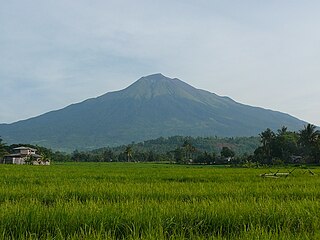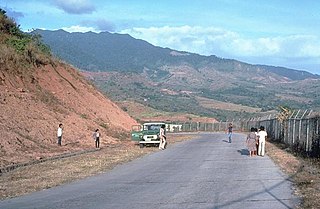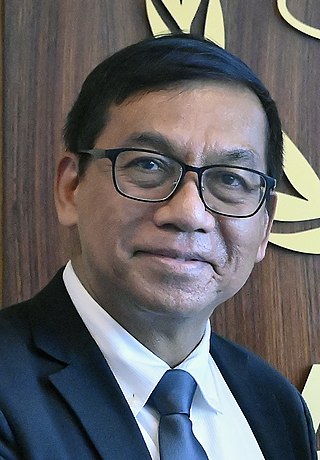
Mayon, also known as Mount Mayon and Mayon Volcano, is an active stratovolcano in the province of Albay in Bicol, Philippines. A popular tourist spot, it is renowned for its "perfect cone" because of its symmetric conical shape, and is regarded as sacred in Philippine mythology.
Dr. Raymundo Santiago Punongbayan was the former director of the Philippine Institute of Volcanology and Seismology (PHIVOLCS) from 1983 to 2002. Punongbayan became popular after handling two well-known calamities, the 1990 Luzon earthquake and the 1991 Pinatubo eruption. PHIVOLCS is the government agency in charge of conducting volcanic and earthquake monitoring in order to generate data that could be used to predict volcanic eruptions and earthquake occurrences.

The Philippine Atmospheric, Geophysical and Astronomical Services Administration is the National Meteorological and Hydrological Services (NMHS) agency of the Philippines mandated to provide protection against natural calamities and to ensure the safety, well-being and economic security of all the people, and for the promotion of national progress by undertaking scientific and technological services in meteorology, hydrology, climatology, astronomy and other geophysical sciences. Created on December 8, 1972, by reorganizing the Weather Bureau, PAGASA now serves as one of the Scientific and Technological Services Institutes of the Department of Science and Technology.

The Department of Public Works and Highways, abbreviated as DPWH, is the executive department of the Philippine government solely vested with the Mandate to “be the State's engineering and construction arm” and, as such, it is “tasked to carry out the policy” of the State to “maintain an engineering and construction arm and continuously develop its technology, for the purposes of ensuring the safety of all infrastructure facilities and securing for all public works and highways the highest efficiency and the most appropriate quality in construction” and shall be responsible for “(t)he planning, design, construction and maintenance of infrastructure facilities, especially national highways, flood control and water resources development systems, and other public works in accordance with national development objectives,” provided that, the exercise of which “shall be decentralized to the fullest extent feasible.”

Kanlaon, also known as Mount Kanlaon and Kanlaon Volcano, is an active stratovolcano and the highest mountain on the island of Negros in the Philippines, as well as the highest point in the Visayas, with an elevation of 2,465 m (8,087 ft) above sea level. Mount Kanlaon ranks as the 42nd-highest peak of an island in the world.

The Department of Agrarian Reform is an executive department of the Philippine government responsible for the redistribution of agrarian land in the Philippines.

The Philippine Science Consortium (PSC), formerly Luzon Science Consortium, was organized by the founding member institutions namely Central Luzon State University (CLSU), Cagayan State University (CSU), and Isabela State University (ISU), known as CLSU-CSU-ISU Science Consortium, on September 17, 1982. The prime objective of the consortium was to improve science education in Luzon upon the advice of the Science Education Institute of the Department of Science and Technology (DOST) under the Institution Building Program (IBP) of then National Science and Technology Authority (NSTA) - Science Promotion Institute.

Science and technology in the Philippines describes scientific and technological progress made by the Philippines and analyses related policy issues. The main agency responsible for managing science and technology (S&T) is the Department of Science and Technology (DOST). There are also sectoral councils for Forestry, Agriculture and Aquaculture, the Metal Industry, Nuclear Research, Food and Nutrition, Health, Meteorology, Volcanology and Seismology.
Mount Leonard Kniaseff, or simply Leonard Kniaseff, is a stratovolcano between the municipalities of Mabini and Maco in the province of Davao de Oro, island of Mindanao, Philippines.

The Philippine Institute of Volcanology and Seismology is a Philippine national institution dedicated to provide information on the activities of volcanoes, earthquakes, and tsunamis, as well as other specialized information and services primarily for the protection of life and property and in support of economic, productivity, and sustainable development. It is one of the service agencies of the Department of Science and Technology.

Mount Natib is a dormant stratovolcano and caldera complex in the province of Bataan on western Luzon Island of the Philippines. The volcano complex occupies the northern portion of the Bataan Peninsula. The mountain and adjacent surrounding is a protected area first declared as the Bataan National Park in 1945.
The 2012 Negros earthquake occurred on February 6 at , with a body wave magnitude of 6.7 and a maximum intensity of VII (Destructive) off the coast of Negros Oriental, Philippines. The epicenter of the thrust fault earthquake was approximately 72 kilometres (45 mi) north of Negros Oriental's provincial capital, Dumaguete.

The Philippine Council for Agriculture, Aquatic, and Natural Resources Research and Development (PCAARRD) is a council of the Department of Science and Technology of the Philippines government.

The National Academy of Science and Technology is the highest recognition and scientific advisory body of the Philippines under the Department of Science and Technology. It was created through Presidential Decree 1003-A issued by President Ferdinand E. Marcos in 1976 to honor and recognize Filipino scientists who made worthy contributions in the advancement of science and technology in the country. It also recommends individuals to be conferred the Order of National Scientist upon approval of the President of the Philippines.

Project NOAH (Nationwide Operational Assessment of Hazard) is the Philippines' primary disaster risk reduction and management program. Managed by the University of the Philippines, it was initially administered by the Department of Science and Technology (DOST) from 2012 to 2017.

Fortunato "Boy" Tanseco de la Peña is a Filipino engineer and professor who served as the Secretary of Science and Technology in the Cabinet of President Rodrigo Duterte from 2016 to 2022. Before he assumed leadership of the Department of Science and Technology (DOST), he was the Undersecretary for Scientific and Technological Services from 2001 to 2014. Except for his brief retirement from 2014 to 2016, he has been with the department since 1982.
The PHIVOLCS Earthquake Intensity Scale is a seismic scale used and developed by the Philippine Institute of Volcanology and Seismology (PHIVOLCS) to measure the intensity of earthquakes.
On July 6, 2017, a 6.5 magnitude earthquake hit Leyte, causing at least 4 deaths and 100 injuries. The quake also caused power interruptions in the whole of Eastern Visayas and nearby Bohol.

The DOSTAdvanced Science and Technology Institute is a research and development organization based in the Quezon City, Philippines. It is one of the research and development institutes of the Department of Science and Technology of the Philippine government.

Renato Umali Solidum Jr. is a Filipino geologist and government official. Solidum has been Secretary of the Department of Science and Technology (DOST) since August 13, 2022. Before his appointment as Secretary, Solidum served as an Undersecretary for Disaster Risk Reduction-Climate Change Adaptation at DOST and as the Officer-in-Charge of the Philippine Institute of Volcanology and Seismology (PHIVOLCS).

















